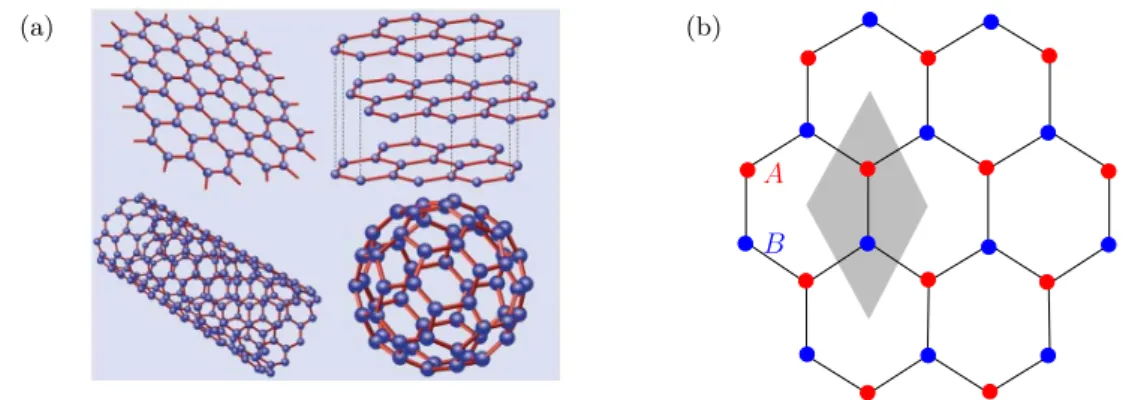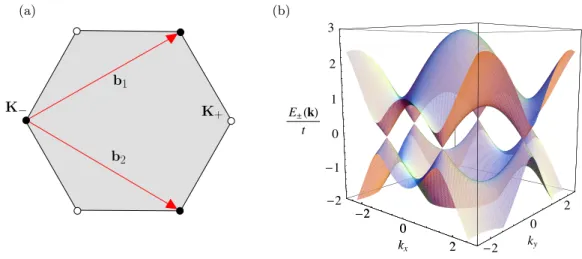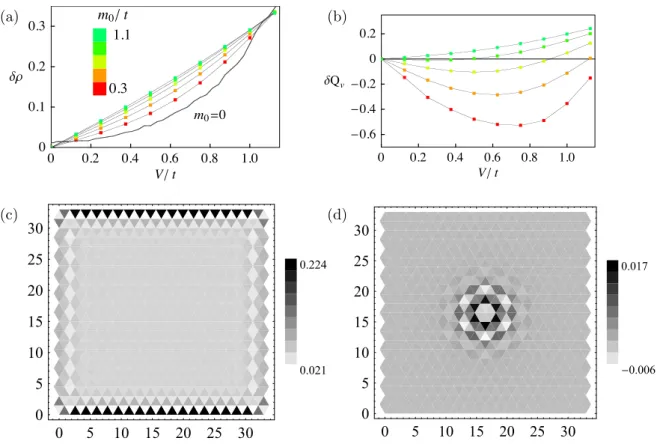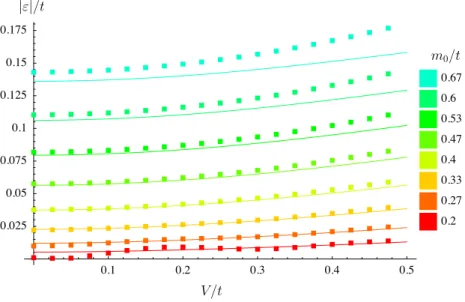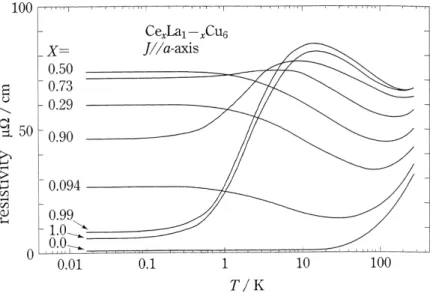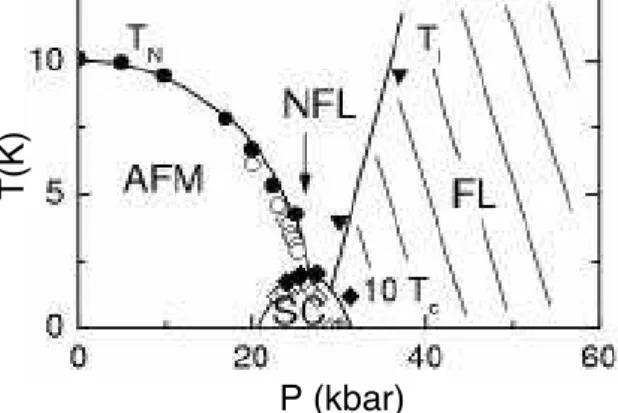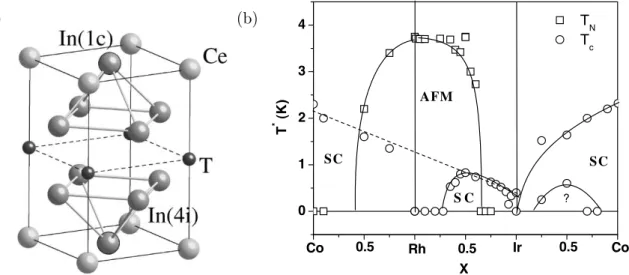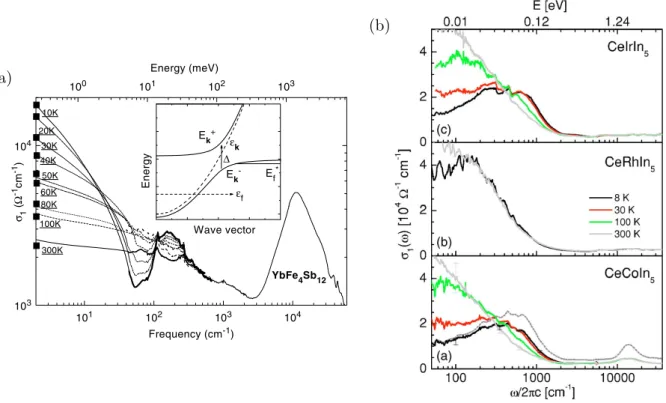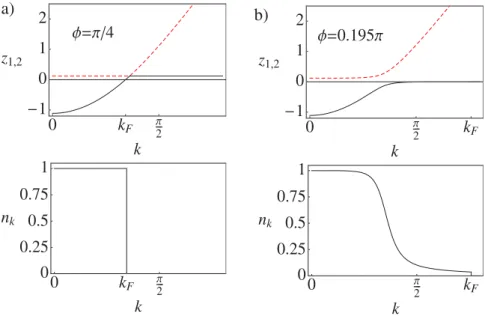Correlated Exotic States:
Fractionalization, Fermi Arcs, Competing Phases
I n a u g u r a l - D i s s e r t a t i o n
zur
Erlangung des Doktorgrades
der Mathematisch-Naturwissenschaftlichen Fakult¨at der Universit¨at zu K¨oln
vorgelegt von Heidrun Weber aus Aalen/W¨urttemberg
K¨oln, 2009
Berichterstatter: Prof. Dr. Matthias Vojta Prof. Dr. Johann Kroha
Tag der m¨undlichen Pr¨ufung: 29. Juni 2009
Abstract
This thesis in the field of condensed matter theory is concerned with various correlated exotic states in different materials. The topic selection is three-fold, covering aspects of graphene, heavy fermion compounds and high-temperature superconductors.
In Part I, a symmetrically biased graphene bilayer is considered, which is discussed to host an exciton condensate. It is shown that in the continuum limit an oddly-quantized vortex in this condensate binds exactly one zero mode per valley index of the bilayer. Intervalley mixing occurring in the full lattice model slightly splits the zero modes in energy. This result is supported by an exact numerical diagonalization of the lattice Hamiltonian for a finite-size system. Such a vortex binds an irrational fraction of “axial” charge and obeys fractional exchange statistics.
Part II is concerned with heavy fermion materials and discusses the consequences of a momentum-dependent hybridization between the conduction band and the localized f elec- trons, especially in the case where the hybridization function has nodes in momentum space.
Such a situation is motivated by experiments, and is in contrast to the commonly studied local hybridization. In the low-temperature regime a highly anisotropic Fermi liquid evolves, for which thermodynamical and optical properties are studied. We find that thermodynamics is dominated by the heavy quasiparticles present in the antinodal direction in momentum space, where the hybridization is strong, while transport is dominated by the behavior of light, nodal quasiparticles. Based on a mean-field approximation, we furthermore study the phase compe- tition between Kondo screening and ordering phenomena induced by intermoment exchange.
According to our findings, it is greatly influenced by the interplay of symmetries of the order parameters in momentum space. The results are applicable to CeCoIn5 and other related heavy fermion compounds.
Part III discusses the recently observed quantum oscillations in the underdoped regime of cuprates and advertises a new mechanism that requires only finite segments of a Fermi surface to exist. Such a situation is indicated by angle resolved photoemission spectroscopy (ARPES) studies, which exhibit so-called Fermi arcs in the normal state of cuprates. We consider a BCS-like model in the vortex state with a pairing gap producing such Fermi arcs. By exact diagonalization of the gauge transformed real-space Hamiltonian it is shown that the density of states at the Fermi level exhibits an oscillatory behavior.
Zusammenfassung
Die vorliegende Arbeit auf dem Gebiet der Theorie der kondensierten Materie besch¨aftigt sich mit diversen korrelierten exotischen Zust¨anden in verschiedenen Festk¨orpern. Die Theme- nauswahl deckt Aspekte dreier Materialientypen ab: Graphene, Schwerfermionenverbindungen und Hochtemperatursupraleiter.
In Teil I wird Zweischicht-Graphene mit symmetrisch angelegter Gatespannung untersucht, das als Host f¨ur ein Exzitonenkondensat diskutiert wird. Es wird gezeigt, dass ein unger- ade quantisierter Vortex in diesem Kondensat im Kontinuumlimes genau eine Zero Mode pro Valley-Index bindet. Die Wechselwirkung zwischen den Valleys, die im vollen Gittermodell existiert, f¨uhrt zu einer leichten Energieaufspaltung der Zero Modes. Dieses Ergebnis wird gest¨utzt durch eine exakte numerische Diagonalisierung des Gitter-Hamilton-Operators f¨ur ein endlich großes System. Ein solcher Vortex bindet einen irrationalen Anteil an “axialer”
Ladung und unterliegt fraktionaler Statistik.
Teil II besch¨aftigt sich mit Schwerfermionenverbindungen und diskutiert die Konsequenzen einer impulsabh¨angigen Hybridisierung zwischen Leitungsband und lokalisiertenf-Elektronen, insbesondere wenn die Hybridisierungsfunktion Knotenlinien im Impulsraum aufweist. Dieser Ansatz ist motiviert durch Experimente, und hebt sich ab gegen¨uber der gemeinhin unter- suchten lokalen Hybridisierung. Im Tieftemperaturbereich bildet sich eine stark anisotrope Fermifl¨ussigkeit aus, f¨ur die thermodynamische und optische Eigenschaften untersucht wer- den. Unsere Ergebnisse zeigen, dass die Thermodynamik von schweren Quasiteilchen do- miniert wird, die sich in den Regionen im Impulsraum ausbilden, wo die Hybridisierung stark ist. Transporteigenschaften hingegen werden haupts¨achlich durch das Verhalten der leichten Quasiteilchen bestimmt, die in der N¨ahe der Knotenlinien der Hybridisierung leben. Basierend auf einer Mean-Field-N¨aherung wird die Phasenkonkurrenz zwischen Kondoabschirmung und Ordnungsph¨anomenen, die sich aus der Wechselwirkung zwischen den lokalen Momenten ent- wickeln, untersucht. Gem¨aß der Ergebnisse ist diese stark beeinflusst durch das Zusammenspiel der Symmetrien der Ordnungsparameter im Impulsraum. Die gewonnenen Erkenntnisse sind anwendbar auf CeCoIn5 und artverwandte Schwerfermionenverbindungen.
In Teil III werden die erst vor kurzem beobachteten Quantenoszillationen im unterdotierten Bereich von Kupraten diskutiert. Es wird ein neuer Mechanismus zur Erzeugung dieser Oszilla- tionen beworben, der nur endliche Abschnitte einer Fermifl¨ache ben¨otigt. Solch eine Situation wird von den Ergebnissen winkelaufgel¨oster Photoemissionsexperimente (ARPES) gest¨utzt, die sogenannte Fermi Arcs im normalleitenden Zustand der Kuprate zeigen. Es wird ein BCS-artiges Modell im Vortexzustand untersucht mit einer Paarungsfunktion, die Fermi Arcs produziert. Mit exakter Diagonalisierung des eichtransformierten Hamilton-Operators im Ort- sraum wird gezeigt, dass ein solcher Ansatz zu einem oszillatorischem Verhalten der Zustands- dichte am Ferminiveau f¨uhrt.
Contents
1 General introduction 5
I Bilayer graphene exciton condensate: Vortices, zero modes, and fraction-
alization 7
2 Introduction 9
2.1 Graphene . . . 9
2.2 Exciton condensates . . . 14
2.3 Fractionalization . . . 16
2.4 Outline . . . 18
3 Exciton condensate in bilayer graphene 21 4 Low-energy theory 27 4.1 Nodal approximation . . . 27
4.2 Zero modes bound by a vortex . . . 28
5 Zero mode splitting 33 5.1 Exact diagonalization . . . 33
5.2 Axial flux and axial charge . . . 35
5.3 Analytic estimate of the zero mode splitting . . . 36
6 Fractional statistics 39 6.1 Gauge-invariant Berry phase . . . 39
6.2 Discrete version . . . 42
6.3 Numerical results . . . 43
7 Conclusion 47
A How to calculate an overlap between two many-body states 49
Bibliography: Graphene 51
II Heavy fermion compounds: Unconventional hybridization 57
8 Introduction 59
Contents
8.1 The Kondo effect: Single-impurity physics . . . 59
8.2 The Kondo lattice and the existence of multiple energy scales . . . 62
8.3 Heavy fermion compounds: experiments . . . 65
8.4 The 115-family . . . 66
8.5 Motivation: Unconventional hybridization . . . 67
8.6 Outline . . . 69
9 Model 71 10 Mean-Field Approximation 75 10.1 Anderson lattice model . . . 76
10.2 Kondo lattice model . . . 77
10.3 Equivalence of Anderson and Kondo mean-field theories . . . 79
11 Low-temperature properties of the Fermi liquid state 81 11.1 Band structure and Fermi surface . . . 82
11.2 Thermodynamical properties . . . 83
11.3 Influence of a magnetic field . . . 87
11.4 Optical conductivity . . . 88
11.5 Thermal and electrical transport . . . 91
12 Temperature-dependent resistivity 95 12.1 Perturbation series for the self-energy . . . 96
12.2 Discussion . . . 99
13 Beyond static mean-field theory 101 13.1 Static vs. dynamical mean-field theory: DMFT . . . 101
13.2 Gauge fluctuations . . . 104
14 Competition between Kondo screening and ordering 105 14.1 Kondo-Heisenberg model . . . 105
14.2 Magnetically mediated superconductivity . . . 106
14.2.1 Mean-field formalism . . . 107
14.2.2 Numerical results: Phase diagrams . . . 109
14.2.3 Analytic estimate: Pairing in the regimes TcTK andTc∼TK . . . . 111
14.3 Magnetic ordering . . . 112
14.3.1 Mean-field approximation . . . 114
14.3.2 Phase diagrams . . . 116
14.3.3 Discussion . . . 117
15 Conclusion 119 B Green functions 121 B.1 Green functions for the Kondo lattice model . . . 121
B.2 Green functions in the presence of a Heisenberg term . . . 121
2
Contents
C Specific heat at low T 123
D Optical conductivity 125
D.1 Current operator . . . 125
D.2 Current-current correlation function . . . 126
D.3 Behavior ofσ1 in the vicinity of the gap . . . 127
E Electrical conductivity 129 F Wiedemann-Franz law in isotropic Fermi liquid theory 131 G Calculation of observables with constrained slave particles 133 H Mean-field Hamiltonian with magnetic ordering 135 H.1 Rewriting . . . 135
H.2 Matrix form . . . 136
Bibliography: Heavy fermion compounds 139 III Cuprate superconductors: Quantum oscillations from Fermi arcs 147 16 Introduction 149 16.1 Cuprate superconductors . . . 149
16.2 Quantum oscillations in metals . . . 154
16.3 Quantum oscillations in cuprate superconductors - an experimental survey . . . 156
16.4 Outline . . . 159
17 Fermi arcs produced by a pairing gap 161 18 Lattice model in a magnetic field 165 18.1 Model . . . 165
18.2 Gauge transformation . . . 166
18.3 Off-diagonal and hopping phase . . . 169
18.4 Bloch equations . . . 171
19 Numerical results 173 19.1 Spectrum and DOS . . . 173
19.2 Frequency analysis . . . 179
19.3 Spatially resolved DOS . . . 182
19.4 Summary . . . 184
20 Conclusion 185
I Bond phase 187
Contents
J Superfluid velocity and phase factors 189
J.1 Superfluid velocity . . . 189
J.1.1 Standard gauge transformation . . . 189
J.1.2 Franz-Teˇsanovi´c gauge transformation . . . 189
J.2 Vortex lattice and the Fourier space . . . 190
J.3 The hopping phase . . . 191
J.4 The off-diagonal phase . . . 192
J.5 The magnetic flux through each plaquette . . . 193
J.6 The inter-unit cell off-diagonal phase Ar0+R(r) . . . 194
K Power spectrum 197
L Semiclassical analysis 199
Bibliography: Cuprate superconductors 203
4
1 General introduction
“Traditional” condensed matter theory is basically built on two cornerstones, which were already developed in the 1930s and 1950s: Landau’s Fermi liquid theory and Landau’s theory of symmetry breaking. Fermi liquid (FL) theory introduces a one-to-one correspondence between the underlying particles, consisting of interacting fermions, and the emerging single-particle fermionic excitations.
FL theory may survive even in the presence of strong correlations - a surprising result re- garding the fact that this concept can be understood as a perturbation theory around the non-interacting ground state. In certain regimes heavy fermion compounds are described by this theory exceedingly well exhibiting heavy quasiparticle excitations. However, the occur- rence of unconventional superconductivity, magnetism and non-Fermi liquid behavior in these materials go way beyond the FL approach (reviews are e.g. given by Stewart, 2001; Coleman, 2007). Cuprates refuse the description in terms of a FL picture for large parts of the accessible phase diagram, but rather show highly unusual physics like a Mott insulating state, high- temperature superconductivity or a pseudogap state, for which a consistent picture could not be established yet (reviews: Damascelli et al., 2003; Lee et al., 2006). The fractional quantum Hall effect, on the other hand, reveals new types of quantum liquids with quasiparticles that have fractional quantum numbers and possibly obey different statistics than the underlying fermions (review: Stormer et al., 1999).
The mentioned discoveries posed new challenges in the field of condensed matter. While all these phenomena arise from the existence of strong correlations between the constituent particles (review: Fulde et al., 2006), the recently isolated material graphene shows that ex- otic physics can also occur in weakly correlated systems (for a short overview see Geim and Novoselov, 2007).
This thesis is concerned with various correlated exotic states in different materials. By exotic, we denote two different types of properties: (i) a FL with unconventional properties, like a symmetry breaking in the style of unconventional superconductivity, or (ii) systems that cannot be described from a FL point of view at all, e.g., because of topological excitations leading to fractionalized quantum numbers or strong correlations like in the underdoped phase of cuprates. To be more specific, we are dealing with the following topics:
Part I: We present a bilayer graphene system with a symmetrically applied gate voltage and study the effect of a vortex in the exciton condensate, which is produced by an interlayer Coulomb interaction.
Part II: We consider a heavy fermion system with a non-local hybridization, study the prop- erties of the highly anisotropic, unconventional Fermi liquid that evolves at low temperatures, as well as the phase competition between Kondo screening and ordering phenomena like su- perconductivity or magnetic ordering.
Part III: We make an attempt to reconcile the recently observed quantum oscillations in the
Bibliography
underdoped regime in cuprates with the Fermi arcs observed by angle-resolved photoemis- sion spectroscopy (ARPES) in the normal-conducting pseudogap phase by investigating the properties of a BCS-like Hamiltonian with a pairing gap producing Fermi arcs.
Bibliography
Coleman, P. Handbook of magnetism and advanced magnetic materials, volume 1, page 95.
Wiley, New York (2007).
Damascelli, A., Z. Hussain, and Z.-X. Shen.Angle-resolved photoemission studies of the cuprate superconductors. Rev. Mod. Phys.75, 473 (2003).
Fulde, P., P. Thalmeier, and G. Zwicknagl. Strongly correlated electrons. In H. Ehrenreich and F. Spaepen, editors,Advances in research and applications, volume 60 ofSolid state physics, pages 1 – 180. Academic Press (2006).
Geim, A. K. and K. S. Novoselov. The rise of graphene. Nature Materials6, 183 (2007).
Lee, P. A., N. Nagaosa, and X.-G. Wen. Doping a Mott insulator: Physics of high-temperature superconductivity. Rev. Mod. Phys.78, 17 (2006).
Stewart, G. Non-Fermi-liquid behavior in d- and f-electron metals. Rev. Mod. Phys. 73, 797 (2001).
Stormer, H. L., D. C. Tsui, and A. C. Gossard. The fractional quantum Hall effect. Rev. Mod.
Phys.71, S298 (1999).
6
Part I
Bilayer graphene exciton condensate:
Vortices, zero modes, and
fractionalization
2 Introduction
Topological states of matter with emergent anyons as quasiparticle excitations are not only characterized by exotic physics, but also have potential applications in the field of topological quantum computation. This explains the quest for easily controllable structures exhibiting such kind of properties.
This part of the thesis is devoted to the topological properties of a physical system that is likely to be realized in a laboratory in the near future: It consists of two layers of graphene separated by a dielectric barrier and subjected to an external electric field. As recently argued, such bilayer systems possibly develop an exciton condensate up to room temperature. We study the possibility of zero modes and fractional excitations arising from vortices in the excitonic order parameter.
In this introductory chapter, we discuss the three underlying aspects of this work. Section 2.1 introduces the material graphene, which due to its lattice structure shows a specific band structure leading to highly unusual physical properties. Section 2.2 reviews the efforts in sta- bilizing an excitonic condensate, which was mostly pursued in the framework of semiconductor physics. Section 2.3 is concerned with general aspects of fractionalization, anyonic statistics and the importance of zero modes. An outline in Sec. 2.4 concludes this chapter.
2.1 Graphene
The first fabrication of graphene (Novoselov et al., 2004), an atomic monolayer of carbon atoms arranged in a honeycomb lattice structure, set off an avalanche of experimental and theoretical investigations. It is a strictly two-dimensional material and was therefore expected to be thermodynamically unstable (Fradkin, 1986). However, five years ago Novoselov et al.
(2004) were able to isolate graphene on an insulating SiO2 substrate.
Graphene can be regarded as the building material of all graphitic forms in various dimen- sions, see Fig. 2.1(a). Three-dimensional (3D) graphite, which can be found in every pencil, is nothing but stacked graphene with interlayer van-der-Waals interactions. Nanotubes (1D) can be thought of as rolled up graphene, while fullerenes (0D) consists of wrapped up graphene with introduced pentagons leading to the required curvature.
Graphene is a zero-gap semiconductor and shows very high crystal quality (Novoselov et al., 2004, 2005; Zhang et al., 2005) with a high mobility of the charge carriers in a large tempera- ture range (Berger et al., 2006). Its band structure is rather special: the low-energy excitations are massless chiral Dirac fermions equivalent to quantum electrodynamics (QED) in 2+1 di- mensions (Castro Neto et al., 2006; Katsnelson et al., 2006; Katsnelson and Novoselov, 2007).
It is therefore a unique example of ‘relativistic’ condensed matter physics.
Reviews on graphene are e.g. given by Geim and Novoselov (2007) focusing on experimental aspects or Castro Neto et al. (2009) illuminating the theoretical background. In the framework
2 Introduction
(a) (b)
B A
Figure 2.1: (a) Different structures consisting of carbon atoms: graphene (top left), graphite (top right), carbon nanotubes (bottom left) and fullerens (bottom right). (Figure from Castro Neto et al., 2009) (b) A honeycomb lattice consists of two triangular sublatticesA andB. The gray shaded zone is the unit cell containing anAandB lattice site.
of this introduction, we will familiarize the reader with the calculation of the band structure based on a tight-binding approximation, show the existence of Dirac fermions, and touch upon transport properties.
Band structure
The honeycomb lattice present in graphene is depicted in Fig. 2.1(b). It is a hexagonal structure consisting of two interpenetrating triangular sublattices A and B. Considering a position in theA-sublattice, the vectors to the nearest neighbors are
rA= 0
−a
,a 2
−√ 3 1
,a
2 √
3 1
, (2.1)
where ais the distance between two neighboringA and B sites.
The robustness and flexibility of this material is due to the strong covalent σ bonds con- necting the carbon atoms, originating from the sp2 hybridization of the atomic orbitals. The remainingpz orbitals are perpendicular to the plane and have weak overlap leading to the for- mation of a half-filledπband. The physics of theπelectrons can be modeled by a tight-binding Hamiltonian with nearest-neighbor hopping
H =−tX
hiji
c†AicBj + h.c.
, (2.2)
where hiji restricts the summation to nearest neighbored sites and cαi is the annihilation operator for an electron at site Ri on sublattice α. Already 60 years prior to isolation of a graphene sheet, its band structure was calculated by Wallace (1947) based on a tight-binding approximation.
10
2.1 Graphene
b1
b2
K+ K−
-2 0
kx 2 -2
0 2 ky
-2 -1 0 1 2 3
E!HkL t
-2 0 kx 2
dispgraph.nb 1
(a) (b)
1
Figure 2.2: (a) The gray region is the first Brillouin zone. The corners of the hexagon are nodal points of the dispersiontk. K− (K+) is equivalent to the other two corners marked by filled (unfilled) circles.
(b) The two bandsE±(k) =±|tk|show linear dispersion at the nodal points.
With the Fourier transformcαi =q
2 N
P
keikRicαk, whereN is the total number of sites in the system andN/2 is the number of unit cells, this Hamiltonian can be rewritten as
H=X
k
(c†Ak, c†Bk)
0 tk t∗k 0
cAk cBk
!
, (2.3)
with the dispersiontk =−tP
rAeikrA. Since the model is spin-degenerate, spin indices were omitted here and their effect will be included in the discussion later on.
The Brillouin zone (BZ) is spanned by the two vectors b1 = 2π
3a √
3 1
, b2 = 2π 3a
√ 3
−1
, (2.4)
and can be shifted into a hexagonal shape, see Fig. 2.2(a). The two evolving bands, the eigenvalues ofH,E±(k) =±|tk|, vanish at the corners of the hexagonal BZ and vary linearly with momentum in the vicinity of these gapless points, see Fig. 2.2(b). Two inequivalent nodal points can be distinguished: K± =
±3√4π3a,0 .
A linear expansion of the bands around K± withk=K±+p leads to
E±(p)' ±vF|p|+O((p/K)2) (2.5)
with K = |K±|and the Fermi velocity vF = 3ta/2, which takes up the role of the speed of light c in this QED 2+1 theory. The experimental data indicate thatvF '106m/s, which is orders of magnitude smaller thanc. In contrast to a quadratic dispersion, the Fermi velocity does not depend on energy, but is constant. The system is degenerate with respect to the valley (±) and spin indices, and therefore SU(4) symmetric.
The massless low-energy excitations are Dirac particles with distinct chirality, which will be shown explicitly in the following.
2 Introduction
Dirac fermions
In the low-energy limit the Schr¨odinger equation with Hamiltonian (2.3) becomes a Dirac equation (Slonczewski and Weiss, 1958; Semenoff, 1984; Haldane, 1988) turning the low-energy excitations into Dirac fermions. In order to prove this claim the k summation in (2.3) is substituted by P
p,n=±, wherendenotes the valley index:
H = X
p,n=±
Ψˆ†Kn(p)
0 tKn+p t∗Kn+p 0
ΨˆKn(p), (2.6)
with the operators ˆΨ†K+(p) = (c†BK++p, c†AK++p) and ˆΨ†K
−(p) = (c†AK
−+p, c†BK
−+p). Lineariz- ing around the nodal pointstK±+p'vF(±px+ ipy) leads to
H 'vFX
p
hΨˆ†K
−(p)(−pxσx−pyσy) ˆΨK−(p) + ˆΨ†K+(p)(pxσx+pyσy) ˆΨK+(p)i
, (2.7) whereσx andσy denote the Pauli matrices. Withp→ −i∇this can be written as a real-space integral,
H 'ivF Z
dxdyh Ψˆ†K
−(r)(σ· ∇) ˆΨK−(r) + ˆΨ†K+(r)(−σ· ∇) ˆΨK+(r)i
, (2.8)
where σ = (σx, σy). Expressed in first quantization, the Hamiltonian reveals that the two- component wave function ψ+(r) of a particle near one of the Dirac point K+ obeys the two- dimensional Dirac equation
−ivF (σ· ∇)ψ+(r) =Eψ+(r). (2.9)
For ψ−(r) a similar relation holds. The wave functions ψ±(r) are connected by time reversal, which in this context corresponds to the operation (kx, ky) → (−kx, ky): While the origin is placed in the center of the hexagonal BZ, Fig. 2.2(a), reciprocal space inversion is accomplished by flipping the sign of the x-component due the symmetry of the problem.
By writing the Hamiltonian (2.7) in terms of the four-component operator Ψˆ†(p) =
Ψˆ†K+(p),Ψˆ†K
−(p)
, (2.10)
it can be shown that it commutes with the γ5 matrix, which is given by a product of all other gamma matrices (e.g. in Weyl representation γ5 =−iγ0γ1γ2γ3=σ3⊗1). This translates into conservation of chirality (Gusynin et al., 2007). The 4-spinors
φ+= (ψ+,0), φ−= (0, ψ−), (2.11)
which describe the quasiparticle excitations at K±, are eigenvectors of γ5 with opposite chi- rality:
γ5φ+ = +φ+, γ5φ−=−φ−. (2.12)
12
2.1 Graphene
For massless particles chirality coincides with helicity, the projection of the momentum oper- ator on the direction of the spin. However, in 2D, the concept of helicity, well defined in 3D, looses its physical meaning. Furthermore, the operatorσdoes not describe the real spin of the electrons, which is omitted in the Hamiltonian, but rather represents a pseudo-spin produced by the lattice structure. Nevertheless, a pseudo-helicity h = 12σ|p|p can be considered, for which the wave functionsψ± are eigenfunctions (Gusynin et al., 2007).
For a broken particle-hole symmetry, e.g. produced by a next-nearest neighbor hopping t0 in the tight-binding approach, the (pseudo-)helicity is not conserved any more, and therefore the particles are not chiral.
The existence of Dirac cones in the spectrum substantially influences the transport properties of graphene. In the following, we provide a short overview about this topic.
Transport properties
Transport in graphene shows highly unusual properties due to the relativistic spectrum in the vicinity of the Dirac points and the spin and valley degeneracy in the system. We summarize what happens under the influence of external electric and/or magnetic fields.
Keeping a single layer of graphene at a gate voltage, the Fermi energy is shifted up or down, which induces electron and hole charge carriers, respectively. The conductivity depends lin- early on the applied voltage, as indicated by measurements of the electric field effect (Novoselov et al., 2005). This allows the conclusion that all induced charge carriers are mobile and not trapped at holes. The mobility stays constant in a temperature range from 10 to 100 K. At the charge neutrality point, i.e., in the absence of a gate voltage, graphene exhibits a finite conductivity, whose origin is still under discussion.
The presence of a magnetic field B perpendicular to the graphene layer introduces a new length scale in the system, the magnetic length lB = p
~c/(eB). Together with the already existing scale, the Fermi velocity vF, there is only one way to construct an energy scale, given by vF/lB (Castro Neto et al., 2009). The cyclotron frequencyωc=√
2vF/lB turns out to be proportional to √
B, whereas it is linear in B in the non-relativistic case. Therefore, the same magnetic field leads to a higher cyclotron energy, which has e.g. the striking effect that the quantum Hall effect (Novoselov et al., 2005; Zhang et al., 2005) survives up to room temperatures (Novoselov et al., 2007)!
The relativistic spectrum, as well as valley and spin degeneracies have strong influence on the quantization itself. For example, in the case of monolayer graphene, the sequence of Hall plateaus,σxy =−4e2/h(N+1/2), acquires an overall factor of 4 and is shifted by an additional 1/2 in comparison to the integer quantum Hall effect observed in GaAs. The Landau levels in monolayer graphene are given byE±,N =±ωc√
N (Gusynin and Sharapov, 2005; Peres et al., 2006; Herbut, 2007).
Up to now, the discussion was restricted to monolayer graphene. Upon stacking layers of graphene, interesting new effects develop. In the framework of this thesis we are especially interested in the possible evolution of an exciton condensate in bilayer graphene. In the next section we discuss various approaches for stabilizing an exciton condensate.
2 Introduction
2.2 Exciton condensates
Generally speaking, an exciton is a bound state of an electron and a hole, well known from semiconductor physics. In this type of material the electron usually sits in the conduction band and the hole corresponds to an unfilled state. The exciton is a charge neutral bosonic particle, which can be created in a semiconductor by shining light at the sample, and decays when the electron and the hole recombine and a photon is emitted. A weakly coupled gas of excitons is expected to form a Bose-Einstein condensate (BEC), similar to Helium-4 or ultracold alkali atoms in vapors (Leggett, 2001; Ketterle, 2002; Cornell and Wieman, 2002), where the condensation leads to superfluidity and coherent matter waves, respectively.
The physical systems that are considered as candidates for hosting an exciton condensate are of layered structure. The motion of the excitons is therefore restricted to two dimensions, and off-diagonal-long-range order is destroyed by phase fluctuations. Two temperatures can be distinguished in such a system: the Bose-Einstein condensation temperatureTBEC and the Kosterlitz-Thouless temperatureTKTwithTBEC< TKT. For increasing temperature the Bose- Einstein condensate with a macroscopically occupied ground state turns into a quasicondensate atTBEC, where only the low energy states are macroscopically occupied. This quasicondensate is superfluid and dissipationless, vortices with opposite circulation are bound in pairs. AtTKT
vortices become unbound leading to a dissipation in the flow. For 2D and infinite system sizeTBEC is zero and becomes finite for finite system size. Since experimentally a distinction between a BEC and a quasicondensate is not possible, the relevant scale for experiments is the Kosterlitz-Thouless temperature, below which superfluidity is present.
Exciton condensate in layered semiconductors
A bulk semiconductor is not very useful when it comes to the observation of an exciton conden- sate (EC): electrons and holes recombine too fast for achieving the required exciton densities (O’Hara et al., 1999). For stabilization, so-called coupled quantum wells are used - systems consisting of layered semiconductor structures: Two semiconductor layers are separated by a thin insulating barrier layer. In experiments three different approaches are basically pursued:
(i) A bilayer system, where an electron-hole plasma is generated by optical pumping. By applying an electric field the electron and hole within one exciton are spatially separated creating a condensate of indirect excitons. Each exciton pair is associated with a dipole moment. The dipolar repulsion between the pairs as well as the spatial separation decreases the recombination rate. Signatures of the condensate are detected by photoluminescence (Butov et al., 2002; Snoke et al., 2002; Lai et al., 2004), however a direct probe of the superfluidity is missing.
(ii) Undoped electron-hole bilayers with an external gate voltage, which induces electrons in one layer and holes in the other (Sivan et al., 1992; Kane et al., 1994; Joglekar et al., 2005). As in system (i) the excitons feel dipolar repulsion, and a dipolar superfluid develops (Balatsky et al., 2004). At high densities, theoretical investigations (Joglekar et al., 2006) hint at the evolution of a Wigner supersolid, a Bose-Einstein condensate with broken translational symmetry.
(iii) A biased electron-electron bilayer quantum Hall systems at νT = 1 (Spielman et al.,
14
2.2 Exciton condensates
Room-Temperature Superfluidity in Graphene Bilayers?
Hongki Min
∗, Rafi Bistritzer
∗, Jung-Jung Su
∗and A.H. MacDonald
11
Department of Physics, The University of Texas at Austin, Austin Texas 78712 (
∗These authors contributed equally to this work.)
(Dated: February 23, 2008)
Because graphene is an atomically two-dimensional gapless semiconductor with nearly identi- cal conduction and valence bands, graphene-based bilayers are attractive candidates for high- temperature exciton condensation. We present estimates which suggest that the Kosterlitz-Thouless temperatures of these two-dimensional counterflow superfluids can approach room temperature.
PACS numbers: 71.35.-y,73.21.-b,73.22.Gk,71.10.-w
Introduction— Exciton condensates were first proposed[1, 2] as possible ordered states of solids more than forty years ago but have proved difficult to realize experimentally. In recent years progress has been achieved in semiconductor bilayer systems with the discovery[3, 4] of equilibrium exciton condensa- tion below T ∼ 1K in the quantum Hall regime, the identification[5] of spontaneous coherence effects in cold optically excited exciton gases, and studies of dynamic condensation[6] of polaritons in non-resonantly pumped optical microcavities. An important advantage of bilayer excitons is the long-range repulsive interaction between aligned exciton dipole moments which prevents droplet formation and favors uniform-density condensed states.
In the weak-coupling limit exciton condensation is a consequence of the Cooper instability[2] of solids with occupied conduction band states and empty valence band states inside identical Fermi surfaces. In bilayer semiconductors conduction band electrons and valence band holes can be induced[7, 8] by external electric fields. Because of their unusual collective transport properties[4, 9, 10, 11] bilayer condensates would have technological potential if order could be achieved at sufficiently high temperatures. As we explain in this Letter, graphene is a particularly attractive candidate for room temperature bilayer exciton condensation because it is atomically two-dimensional, because it is a gapless semiconductor, and because its two-dimensional massless Dirac band structure implies nearly perfect particle-hole symmetry and stiff phase order.
We consider a system[12] with two graphene layers em- bedded in a dielectric media and placed within a parallel- plate capacitor as illustrated schematically in Fig. 1.
Each layer has Dirac-cone bands centered at two inequiv- alent points in the graphene Brillouin-zone. In the ab- sence of an external bias field, the two layers are sepa- rately neutral and their Fermi energies lie exactly at the Dirac points. When the capacitor is charged, however, equilibrium between the layers is maintained by charge transfer. The Fermi level lies in the graphene conduction
FIG. 1: (Color online) left:Schematic illustration of a graphene bilayer exciton condensate channel in which two single-layer graphene sheets are separated by a dielectric (SiO
2in this illustration) barrier. We predict that electron and hole carriers induced by an external gate will form a high- temperature exciton condensate. right: The two band model.
We neglect the two remote bands indicated by dashed lines.
hole symmetry of the Dirac equation ensures perfect nest- ing between the electron Fermi sphere in the n-type layer and its hole counterpart in the opposite layer, thereby driving the Cooper instability. The condensed state es- tablishes spontaneous long-range coherence between the two graphene layers.
Our main interest here is in providing an esti- mate of the maximum possible Kosterlitz-Thouless (KT) temperature T
KTof these two-dimensional counterflow superfluids[4]. Because the remote bands (the occupied valence band of the n-type layer and the empty con- duction band of the p-type layer) are of little impor- tance when T
KTis large (as we explain later) they can be neglected to obtain a two-band model. Our T
KTesti- mate is constructed from mean-field (Hartree-Fock) the- ory calculations[13] of the temperature dependent phase stiffness of the ordered state.
Our main result is the normal to superfluid phase boundary depicted in Fig. 2. The KT temperature is plotted as a function of the separation between the layers d and the electric field E
extbetween the external gates.
We estimate that superfluidity can survive at room tem- perature under favorable experimental conditions. For
arXiv:0802.3462v1 [cond-mat.mes-hall] 23 Feb 2008
Figure 2.3: Suggested experimental setup for producing an exciton conden- sate in bilayer graphene. The layers are embedded in a dielectric, e.g. SiO2, and subjected to the electric field pro- duced by a parallel-plate capacitor.
(Figure from Min et al., 2008).
2000; Eisenstein and MacDonald, 2004; Eisenstein, 2004; Tutuc et al., 2004; Kellogg et al., 2004). In this case both of the semiconducting layers serve as a well for electrons. However, in the quantum Hall regime the system can be mapped onto an electron-hole system with attractive interaction: An external magnetic field leads to Landau levels with a filling factorν denoting the fraction between the number of electrons in the system and the number of states in each Landau level. The system is invariant under particle-hole transformation, which can be performed in only one of the two layers leading to a hole filling factor of 1−ν. The former empty sites are now seen as occupied by holes with positive charge and the interaction between holes and electrons in different layers is attractive. The number of electrons and holes in the system becomes equal forν= 1/2 for each layer, i.e., a total filling factorνT = 1/2 + 1/2 = 1.
As above the excitons carry a dipole moment, but unlike in system (ii) this is not expected to lead to a supersolid state. Such a system seems to be the most promising candidate among semiconductor heterostructures for exciton condensation.
A first experimental hint for excitonic BEC in an electron-electron quantum Hall bilayer system was given by measurements of the interlayer tunneling rate (Spielman et al., 2000), which reveal strong interlayer electron-hole correlations. Striking evidence was given by mea- surements of the counterflow of electrons and holes by independently electrically connecting to the layers (Tutuc et al., 2004; Kellogg et al., 2004). The small, but measurable dissipation in the counterflow channel was argued to arise from unbound vortices produced by disorder in the sample (Eisenstein and MacDonald, 2004). All experimental evidence was achieved in a temperature regime well below 1 K.
Exciton condensate in bilayer graphene
Recently, interest arose in exciton condensation in graphene bilayers (Min et al., 2008; Zhang and Joglekar, 2008). A possible experimental setup is depicted in Fig. 2.3: Two layers of graphene separated by a dielectric are subjected to a perpendicular electric field that induces electron charge carriers in one layer and holes in the other. The intervening dielectric sup- presses inter-layer hopping, which would counteract the evolution of an EC (Dillenschneider and Han, 2008). The value of the Kosterlitz-Thouless transition temperature is sensitive on the strength of the Coulomb interaction and its possible screening by the carriers in the layer.
Depending on the importance of screening,TKT was estimated to be in the range of room tem-
15
2 Introduction
perature (Min et al., 2008; Bistritzer et al., 2008) or a few mK (Kharitonov and Efetov, 2008, 2009). TKT is expected to be reduced by disorder (Kharitonov and Efetov, 2009): Electrons and holes do not scatter identically at impurities in the two layers, which leads to a breaking of the electron-hole pair. As argued by Zhang and Joglekar (2008), no Wigner crystallization occurs in graphene bilayers despite the dipole moments carried by the excitons.
Differences between such a bilayer graphene and a layered semiconductor structure are various. Since graphene is a gapless semiconductor, higher carrier densities can be achieved.
The fairly good particle-hole symmetry of the band structure favors the evolution of an EC.
In contrast to the phonon-mediated superconductors, with transition temperatures orders of magnitudes smaller than room temperature, the Coulomb interaction producing the EC ranges over the full band width instead of a narrow shell around the Fermi surface of the order of the Debye energy.
Like a superconductor, an exciton condensate can develop vortices, which are possibly related to zero energy eigenfunctions, so-called zero modes. Their relation to fractionalization is pointed out in the next section.
2.3 Fractionalization
Fractionalized quantum numbers and fractional statistics arising from nontrivial topological configurations are not just interesting by themselves as exotic phenomena. Systems with theses properties might offer a route to fault-tolerant quantum computation (Kitaev, 2003; Nayak et al., 2008), because the states are topologically protected from local perturbations.
Up to now only two systems are known that host the required non-Abelian anyonic excita- tions: the fractional quantum Hall state with filling factor ν = 5/2 (Moore and Read, 1991) and the planar spin-polarized p+ip superconductor (Read and Green, 2000). Since both sys- tems are not easy to produce and control, it is highly desirable to investigate the occurrence of quasiparticles with fractional statistics in other systems.
In this section, we first discuss the relation between fractional quantum numbers and frac- tional statistics, and then present examples of systems with fractional excitations, while point- ing out the importance of zero modes.
Fractional statistics
Exchanging two equivalent particles in a system leads to an additional phase factor exp(iθ) in the global wave function. Twice an exchange of the same two particles corresponds to tracking one particle around the other, called braiding. In a three-dimensional system such a two-fold exchange leaves the wave function unchanged due to topology, and all particles fall in one of the two categories: either they are bosons with an exchange phase θ = 2π or fermions with θ =π. In two dimensions the situation is different: θ is not restricted to 2π and π, but can in principle take any value, which however mostly is a faction of π, leading to a new particle species dubbed anyon (Wilczek, 1990).
In order to illustrate the relation between the fractional charge of a quasiparticle and the associated fractional statistics, we consider the example of the fractional quantum Hall effect
16
2.3 Fractionalization
(FQHE) with filling factorν = 1/3, where the low-energy excitations are Abelian anyons. At ν = 1/3 the lowest Landau level is filled to one third and the ration between electrons and penetrating flux quantums in the system is 1:3. Upon a Chern-Simons transformation, where two flux quanta are attached to each electron, the ground state can be regarded as being equivalent to a fully filled lowest Landau level (ν = 1) of composite fermions. Quasi-hole excitations above this ground state are composite objects carrying one flux quantum and a chargee/3 (Laughlin, 1983). The exchange statistics θ= 2πνφ/φ0, whereφ0=h/eis the flux quantum and φ denotes the flux carried by the quasiparticle, is obtained by calculating the Berry phase on the basis of the underlying Laughlin wave function (Arovas et al., 1984). This is in agreement with the interpretation that the exchange of two flux-charge composite objects with fluxφand charge q leads to a topological phase (Wilczek, 1990)
θ= 2π φ φ0
q
e. (2.13)
Such a phase can be regarded as a generalization of the Aharonov-Bohm phase (Aharonov and Bohm, 1959), where the wave function of an electron acquires a phase 2πφ/φ0 when encircling a magnetic fluxφ. From relation (2.13) it becomes clear how fractional charge in combination with flux can be connected to fractional statistics. Please note that the existence of fractional charge itself is not a sufficient condition for the occurrence of fractional statistics.
Anyons, whose braiding simply manifests itself in a phase change, Eq. (2.13), are Abelian.
In this case the ground of a system consisting of several anyonic quasiparticles is unique.
Therefore, the order of braiding operations does not matter for the overall phase change: the braid group is commutative. For non-Abelian anyons this is not the case. The ground state is degenerate, and braiding two particles does not necessarily correspond to only a phase change in the initial wave function. This property is needed for the concept of topological quantum computation (Nayak et al., 2008).
In the following we point out the role of zero modes for the occurrence of fractional quantum numbers.
Zero modes and fractionalization
Given that charge is a good quantum number, a single localized zero energy eigenfunction in a gapped system with a symmetric spectrum binds a charge of 1/2 (Jackiw and Rebbi, 1976; Su et al., 1979; Hou et al., 2007; Seradjeh et al., 2008b). In some cases this can be illustrated by simple counting arguments regarding the real-space structure of the system, e.g. (Seradjeh et al., 2008b). The existence of a zero mode itself is not a necessary condition for the existence of fractionalization. Mid-gap bound states away from zero energy for instance can bind fractional charge as well (Chamon et al., 2008).
Systems with fractionalization can be divided into those, where time reversal is broken or conserved. On the basis of two examples we illuminate the relation between zero modes and fractionalization. We discuss the planar chiral p-wave superconductor, whose half-quantum vortices bind fermionic zero modes leading to non-Abelian anyonic excitations, and, as a repre- sentative of systems with conserved time reversal symmetry, present a graphene-like structure with a Kekul´e dimerization pattern.
2 Introduction
Figure 2.4: Illustration of a Kekul´e dis- tortion on a honeycomb lattics. Atoms linked by double bonds are closer than those linked by single bonds. (Figure from Jackiw, 2007).
(perfect matching)
Figure 6: Effect of Kekul´e distortion: atoms are closer together for double bonds, further apart for single bonds. The pattern is “perfectly matched”: at each node there are two single bonds and one double bond.
ϕ is neutral. Additionally, the interaction term is invariant against a simultaneous phase change ofψ andϕ:
ψ →eiωγ5ψ, ϕ→e2iωϕ.
This invariance may be promoted to a local gauge invariance, provided the kinetic term is gauged by the vector potential A, coupling to ψ in a chiral manner. Thus the complete fermion Hamiltonian becomes [2]
HF =ψ†α·[p−γ5A] ψ+g ψ†β[ϕRe−i γ5ϕIm] ψ, leading to the Dirac equation
h(ϕ,A)ψ =α·(p−γ5A)ψ+gβ(ϕRe −i γ5ϕIm)ψ=E ψ.
The Bose fields satisfy the vortex equations.
D·Dϕ=ϕV!(ϕ∗ϕ) Dϕ≡(∇ −i2A) ϕ
1
e2 εij∂jB =jBOSEi B ≡εij∂iAj jBOSE= 4Im ϕ∗Dϕ
7
A spin-polarized p+ip superconductor exhibits vortices with a flux ofh/2e. The physics in the presence of a vortex can be analyzed in terms of a BCS mean-field theory. The solution of the Bogoliubov-de Gennes (BdG) equations reveals a bound fermionic mid-gap zero-energy mode (Read and Green, 2000; Gurarie and Radzihovsky, 2007) localized in the vicinity of the vortex core. Since the considered system is a superconductor and therefore the degrees of freedom are in the particle-particle channel, this mode corresponds to a self-conjugated fermion, termed Majorana fermion, for which the creation operator γ† fulfills the relation γ†=γ. In a system with several vortices this leads to a ground state degeneracy (Read and Green, 2000; Ivanov, 2001) and the vortices behave as anyons with non-Abelian statistics. The fractional statistics, however, in this example is not accompanied by charge fractionalization, since charge is not conserved in a superconductor.
Examples of systems exhibiting zero modes and fractionalization, while conserving time reversal symmetry, are for instance lattice models with a specific dimerization pattern (Hou et al., 2007; Seradjeh et al., 2008b). They can be regarded as a two-dimensional generalization of the concept of fractionalization in polyacetylene, a dimerized chain, where a domain wall in the dimerization pattern binds a mid-gap zero-energy excitation and is associated with fractionalized charge 1/2 (Jackiw and Rebbi, 1976; Su et al., 1979; Goldstone and Wilczek, 1981). The system considered by Hou et al. (2007) is a graphene-like structure: a honeycomb lattice with spinless, charged fermions with Kekul´e distortion (Fig. 2.4), a dimerization pattern that generates a mass term for the Dirac electrons. A U(1) vortex in this mass, analogously to an Abrikosov vortex in a superconducting condensate, is associated with a 2π phase twist around the vortex core. In the presence of such a vortex the low-energy Dirac equations are equivalent to the BdG equations for a chiral p-wave superconductor with a half-quantum vortex (Read and Green, 2000). A vortex binds an unpaired zero mode and a charge of ±e/2.
In contrast to the p-wave superconductor, the zero mode cannot be expressed as a Majorana fermion. Therefore, the exchange statistics of these vortices is Abelian (Seradjeh et al., 2008b).
So far, in all considered systems, only vortices with odd vorticity bind zero modes.
2.4 Outline
The possibility of creating zero modes and fractional excitations in the exciton condensate evolving in a bilayer graphene system with an applied gate voltage is explored. In the low- energy limit we show that an oddly-quantized vortex in the excitonic order parameter binds two zero modes - one per valley index. The inter-valley mixing, which is not captured by the low-energy theory, leads to a slight splitting of these zero modes. Based on an exact numerical
18
2.4 Outline
diagonalization of the full lattice Hamiltonian in real space, we study the charge content and the exchange statistics of these vortices. Although not associated with a total charge, each vortex binds an irrational fraction of “axial” charge defined as the charge difference between the layers and obeys fractional exchange statistics. The results presented in the framework of this thesis have been published in (Seradjeh et al., 2008a).
Section 3 introduces the Hamiltonian modeling the symmetrically biased bilayer system and studies its instability towards an excitonic condensate at the mean-field level. Section 4 discusses the approximations arising in the low-energy limit and studies the effect of a vortex in the excitonic order parameter. Section 5 provides numerical and analytical results showing the splitting of zero modes due to inter-valley mixing beyond the low-energy regime.
It furthermore shows the association of a vortex with axial charge. Section 6 discusses the theoretical background and numerical results studying the exchange statistics of the vortices.
A summary of the results and an outlook to possible experimental observations in Sec. 7 concludes this part.
2 Introduction
20
3 Exciton condensate in bilayer graphene
In this chapter we consider a symmetrically biased bilayer graphene system and investigate its instability towards an excitonic condensate using a mean-field approximation. We derive the critical value for the Coulomb repulsion and the dependence of the excitonic order parameter on the values of the Coulomb repulsion and the gate voltage.
The schematic structure of the regarded system is depicted in Fig. 3.1(a) - each of the graphene layers is kept on an electric potential±V. The layers are separated by a dielectric material at a distance much larger than the lattice spacing within the layers. A finite gate voltageV >0 shifts the spectrum up and down, respectively, in the upper and lower layer. At half filling this leads to a Fermi surface of particles in one layer, and of holes in the other one.
Therefore, a Coulomb interaction between the layers condenses a finite density of particle-hole bound states. The exciton condensate (EC) possibly exists even up to room temperature (Min et al., 2008). Only weak dependence on the actual type of stacking is expected (Zhang and Joglekar, 2008). Therefore, direct stacking will be assumed.
The considered model containing the essential physics is described by the HamiltonianH= H1+H2+HU with the in-layer Hamiltonian
Hα =−tX
hiji
(c†Ai,αcBj,α+ h.c.)−(−)αVX
νi
nνi,α, (3.1)
wherehijidenotes the summation over nearest-neighbored sites,α = 1,2 represents the layer andν =A, B the sublattice index. cνi,α is the fermionic annihilation operator for an electron sitting at positionRi on sublattice ν and layer α, and nνi,α =c†νi,αcνi,α is the corresponding
+V
-V
SiO2
layer 1 layer 2
d
struc.nb 1
N
+V
−V
(a) (b)
!
"2w w=√
m2+V2
!"2m
(a) (b)
k
Energy
Figure 3.1: (a) Structure of bilayer graphene subjected to a gate voltageV and separated by a dielectric, e.g. SiO2, at a distance d a, where a is the intra-layer lattice spacing. (b) Spectrum for bilayer graphene close to a nodal point in the non-interacting case with zero gate voltage (green dashed line, doubly degenerate) and in the presence of an exciton condensate (red solid line) with finite gate voltage V, an exciton gapm= ∆− and a nodal shift of w=√
m2+V2.
21
3 Exciton condensate in bilayer graphene
Figure 3.2: Schematic illustration of exci- tons that consist of a hole and an electron
from different layers. layer 1
layer 2
- -
+
-
+ +
struc.nb 1
number operator. The interaction term is given by HU =UX
νi
nνi,1nνi,2. (3.2)
Since spin indices do not influence the behavior of the EC, just a single spin projection is considered. Inter-layer hopping is exponentially suppressed by the comparably large inter-layer distance and the intervening dielectric, and is therefore omitted in the Hamiltonian. Electrons can hop within each layer to nearest neighbored sites. The assumed interaction is short-ranged and acting between two particles in different layers and on the same planar site, neglecting a possible long-ranged tail of the Coulomb interaction, which however is only expected to enhance the formation of the EC.
A mean-field decoupling in the excitonic order parameter ∆νi =UD
c†νi,2cνi,1E
, whereν repre- sents the sublattice index, leads to the mean-field Hamiltonian
HMF=H1+H2−X
νi
∆νic†νi,1cνi,2+ h.c.
+ 1 U
X
νi
|∆νi|2. (3.3)
A phase with a finite value of ∆νi describes an exciton condensate illustrated in Fig. 3.2.
Under the assumption that ∆νionly depends on the sublattice index, there are two mean-field parameters ∆A and ∆B in the system, which can be combined to ∆± = 12(∆A±∆B). We can define the spinor field operator ψi= (cBi,1,−cAi,1, cBi,2, cAi,2)T. The Hamiltonian (3.3) is compactly written as
HMF= 1 N
X
k
ψ†khkψk+E0 (3.4)
using N as the number of sites per layer, E0 = (N/U)(|∆+|2+|∆−|2) and hk=γ0
γ1Retk+γ2Imtk+V γ0γ5+|∆−|e−iχ−γ5−iγ1γ2|∆+|eiχ+γ5
. (3.5)
tk=−tP
rA∈n.n.eikrA is the non-interacting dispersion relation, whererAdenotes the vectors pointing from an A site to the nearest neighbored B sites, see Eq. (2.1), and γµ= iσ2⊗σµ, γ0=σ1⊗1andγ5=−iγ0γ1γ2γ3 =σ3⊗1are the Dirac matrices in Weyl representation. The field ∆± =|∆±|eiχ± was decomposed in a polar representation.
The eigenvalues of hk, Eq. (3.5), are given by ±Ekτ with Ekτ = |tk|2+V2+|∆+|2+|∆−|2+
−(−1)τ2
|tk|2 V2+|∆+|2
+ Re2(∆−∆∗+)1/21/2
, (3.6)
22
whereτ = 1,2 is the band index. For half filling the ground state energy of the system reads EGS=−X
kτ
|Ekτ|+E0 with E0= 2N
U (|∆+|2+|∆−|2). (3.7) The energy gapEg in the system is given by the minimal energetical distance between the ground state and an excited state. Since|Ek2| ≤ |Ek1|, we minimize the energy∂|Ek2|/∂tk≡0, which leads to the condition
|tk|2 ≡ v4−Re2(∆−∆∗+)
v2 , (3.8)
where the shortcutv2=V2+|∆+|2 was introduced. Ek2 evaluated with this condition leads to an expression for the energy gap
Eg=
|∆−|2V2+ Im(∆−∆∗+)2 V2+|∆+|2
1/2
. (3.9)
The maximum value of the gap is realized when Re(∆−−∆∗+) = 0, or equivalently|∆A|=|∆B|. For the two parameters ∆+ and ∆− two separate gap equations hold with different critical valuesUc±. The gap equations are obtained by minimizing the ground state energy ∂E∂∆GS
± = 0.
In the limit ∆± → 0 the value of the critical interaction Uc± can be extracted. The explicit calculation of Uc± presented in the following shows an instability at infinitesimal U towards an EC with non-zero ∆− and zero ∆+.
While setting ∆−= 0, the gap equation for ∆+ 4N =UX
kτ
v−(−1)τ|tk|
v|Ekτ| (3.10)
leads to the critical value 1
Uc+ = X
k,|tk|<V
1
N V . (3.11)
In the vicinity of the nodes, we approximate the non-interacting dispersion as|tk|= (3ta/2)|k|, which implies a density of states linear in energy forV t. Within this limit, we can estimate Uc+∼t2/V t.
In an analogous calculation for ∆− the gap equation becomes 2N =UX
kτ
1
|Ekτ|. (3.12)
In the limit ∆−→0 with ∆+= 0, this reduces to 1
Uc− = 1 2N
X
kτ
1
||tk| −(−1)τV| (3.13)
